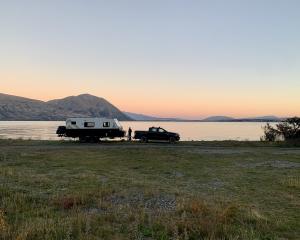When former Otago Daily Times journalist Oscar Francis agreed to what he thought would be a serene day-trip, he had little idea he was about to embark on a rainy-season ride through some of the darker chapters in Cambodian history.
Even by the generally relaxed standards of Cambodia, time hits differently in Kampot.
A small town of about 32,000 located at a river junction in eastern Cambodia, Kampot is a 20-minute drive from the coast and an hour away from the Vietnamese border.
World famous for its pepper exports, Kampot is home to a close-knit expat community, many of whom moved to Kampot from Sihanoukville after a wave of Chinese investment transformed the coastal city into a Mafia-ridden cluster of half-built tower blocks over the span of a few short pre-pandemic years.
In contrast, Kampot is filled with cute cafes, rustic restaurants and a bevy of bars, where the going price for of a beer is an American dollar.
One British expat working as a bartender explained to me that, with little in the way of effective law-enforcement presence, Kampot effectively exists in a form of peaceful anarchy.
That much was evident from seeing retired Westerners openly smoking cannabis at sidewalk cafes. The locals enjoy a relaxed pace of life, and are happy to live and let live. Altogether, Kampot is not a place where people struggle from working too hard.
All of this is to say, I did practically nothing during the fortnight I spent there. Each day I would bounce from cafe-to-restaurant-to-bar, killing time by reading in the heat and trying to stay out of the afternoon rain, which would periodically flood the street outside my hostel.
A pair of expat friends, Adam and Marie, were returning to Kampot after a long time away. They prised me out of my extended reverie by inviting me on a motorbike trip up Bokor Mountain, a kilometre-high peak which overlooks the town.
It would be fun, they said.
I did not know it when we set off, but the mountain has something of a dark history.
In the subsequent peace, it flourished for some years until it was seized by the Khmer Rouge in 1972. It was one of their last strongholds, until they were pushed out by French peacekeepers 30 years later.
Despite a few clouds, we left on a beautiful morning. We rode up through the lush Preah Monivong Bokor National Park, passing families of macaques holding court on the roadside.
Atop the mountain, hulking shells of condominiums lurched out of the ground, accompanied by billboards advertising an incipient city although, it would be hard to describe the scene as being exactly a hive of construction activity.
Hungry for lunch, we made our first stop at the gargantuan Thansur Sokha Hotel. The vast lobby was practically deserted. The adjoining dining room was immaculate. It contained us, a French tourist we adopted in the parking lot and a man working on a laptop in the far corner.
I dug in with relish, although it might have put me off my meal if I had known the hotel is adjacent to several compounds where human trafficking victims are allegedly being held to operate online scams.
At the hotel’s spartan minimart, I brought a mysterious energy drink, called Vigor Power Ice, which tasted like the aftertaste of mint toothpaste.
There was a ramshackle shrine with a wooden cross, an offering of perfume and a statuette of a preacher with his anointing arm broken off.
Behind the church, a terrific cliff-top view looks out across the lowlands and the Gulf of Thailand below. On a less cloudy day I would have been able to see as far as the Vietnamese island of Phu Quoc.
We continued merrily up the road, past the ornate Le Bokor Palace Hotel.
Built in the finest art-deco style, its clifftop casino was once the centerpiece of the hill station. During the First Indochina War, it was used as a hospital and later was sacked by Khmer nationalist forces.
We parked our bikes at the road-end nearby, and wandered down to explore the remnants of the abandoned town. Broken glass and half-opened bags of concrete littered some buildings, while others had become impromptu gardens.
We poked around for a while and I got my shoes wet in the mountaintop marsh which the town had evidently been built on. As I was looking for dry rocks to jump to, a swirling white fog rolled in, reducing visibility to near-zero.
We clawed our way back. As soon as we reached our bikes, the mist disappeared as quickly as it had arrived. We made our way to Popokvil Waterfall, via a stop at the side of the road to admire some immense turkeys at a local free-range poultry farm.
Across the road, we inspected the ruins of the late King Sihanouk’s former summer house, known as The Black Palace. The muddy compound was overgrown, full of barking frogs and home to some particularly impressive graffiti murals.
Sodden, hungry and struggling to differentiate between bike and room key, I delivered myself to the grinning uncle who had hired us the bikes. After an urgent feed and a change of clothes, I found my way to the excellent Adina bar where I bought a beer and threw myself down in a comfy seat with a pleasant book.











